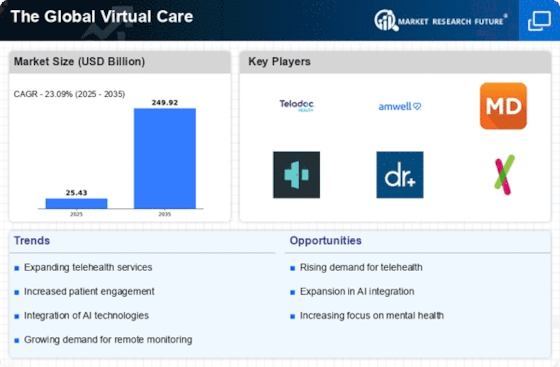Technological Advancements in Healthcare
Technological advancements play a crucial role in shaping The Global Virtual Care Industry. Innovations such as artificial intelligence, machine learning, and wearable devices are transforming how healthcare is delivered. For instance, AI-driven chatbots are increasingly utilized for preliminary diagnosis and patient triage, streamlining the care process. The market for wearable health technology is expected to reach USD 60 billion by 2023, indicating a growing reliance on technology for health monitoring. These advancements not only improve the efficiency of healthcare delivery but also enhance the quality of care provided to patients. As technology continues to evolve, it is likely to further facilitate the expansion of virtual care services, making them more effective and user-friendly.
Regulatory Support for Telehealth Services
Regulatory support is emerging as a significant driver in The Global Virtual Care Industry. Governments and health authorities are increasingly recognizing the importance of telehealth in improving healthcare access. Recent policy changes have expanded reimbursement for telehealth services, encouraging healthcare providers to adopt virtual care solutions. For example, the Centers for Medicare and Medicaid Services (CMS) has broadened the scope of covered telehealth services, which has led to a notable increase in telehealth utilization. This regulatory backing not only fosters innovation but also instills confidence among healthcare providers and patients alike. As regulations continue to evolve, they are likely to create a more favorable environment for the growth of virtual care services.
Increased Emphasis on Mental Health Services
The increased emphasis on mental health services is significantly influencing The Global Virtual Care Industry. With rising awareness of mental health issues, there is a growing demand for accessible mental health care. Virtual platforms provide a convenient avenue for individuals to seek therapy and counseling without the stigma often associated with in-person visits. Data suggests that the mental health app market is expected to reach USD 3 billion by 2025, reflecting the increasing acceptance of digital mental health solutions. This trend is likely to encourage healthcare providers to expand their virtual care offerings to include mental health services, thereby enhancing the overall scope of virtual care.
Rising Demand for Remote Healthcare Solutions
The increasing demand for remote healthcare solutions is a pivotal driver in The Global Virtual Care Industry. As patients seek more convenient and accessible healthcare options, telehealth services have gained traction. According to recent data, the telehealth market is projected to reach USD 459.8 billion by 2030, reflecting a compound annual growth rate of 37.7%. This surge is attributed to the growing preference for virtual consultations, which offer flexibility and reduce travel time. Furthermore, the rise in chronic diseases necessitates continuous monitoring, making virtual care an attractive option for both patients and healthcare providers. The integration of remote monitoring tools enhances patient engagement and adherence to treatment plans, thereby driving the demand for virtual care solutions.
Growing Focus on Cost-Effective Healthcare Solutions
The growing focus on cost-effective healthcare solutions is a driving force in The Global Virtual Care Industry. As healthcare costs continue to rise, both patients and providers are seeking alternatives that offer value without compromising quality. Virtual care services often reduce overhead costs associated with traditional in-person visits, making them an attractive option for healthcare systems. A study indicates that telehealth can save healthcare systems up to USD 4.28 billion annually by reducing unnecessary emergency room visits and hospital admissions. This financial incentive, coupled with the convenience of virtual consultations, is likely to propel the adoption of virtual care solutions across various demographics, including underserved populations.


















Leave a Comment